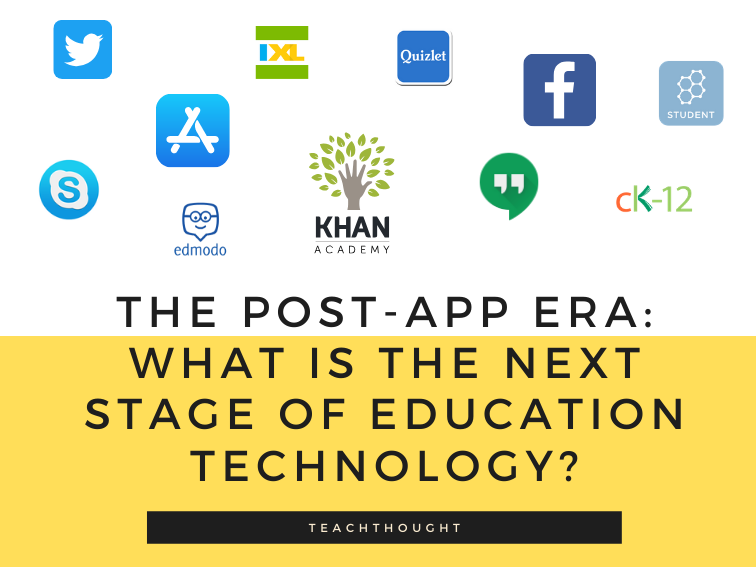
The Post-App Era: What Is The Next Stage Of Education Technology?
What are the stages of education technology?
The Stages of Educational Technology Integration: A Research Perspective
by TeachThought Research • Updated September 16, 2025
Educational technology adoption follows patterned, observable stages. Naming those stages helps leaders diagnose current practice, select targeted interventions, and plan sustainable growth across curriculum, assessment, and professional learning.
Stage 1: Pre-integration
Technology is present but rarely shapes instruction. Devices live on carts. Network reliability is inconsistent. Teachers report low self-efficacy and rely on analog materials. Typical evidence includes sporadic projector use and limited LMS logins. Barriers are both external (access, time, support) and internal (beliefs about pedagogy and value), which research distinguishes as first- and second-order constraints.
Stage 2: Adoption and Transition
Schools pilot tools in small cohorts. Use is task-specific and substitutional: slide decks replace transparencies, PDFs replace handouts. Professional development is tool-centric and introductory. Leadership identifies early exemplars and begins documenting use cases. For classroom planning language, many teachers reference SAMR to classify activity depth; see TeachThought’s primers and exemplars for practical frames and examples.
Stage 3: Development and Integration
Technology is planned into units and assessments rather than appended the night before. Infrastructure improves: reliable bandwidth, consistent device ratios, ticketing for support. Teams adopt shared templates for tech-enabled tasks and calibrate expectations in PLCs. Lesson artifacts show alignment among standards, cognitive demand, and digital task design. Faculty begin monitoring usage data and simple outcome indicators such as completion rates and item-level performance on digital assessments.
Teacher knowledge shifts from “how the tool works” to technological pedagogical content knowledge. For a concise definition and example language, see the TPACK entry in the TeachThought Teaching Dictionary.
Stage 4: Transformation and Expansion
Pedagogy changes to exploit unique digital affordances. Teachers move beyond substitution to task redesign and new learning opportunities: real-time formative checks, adaptive pathways, student publishing, and authentic data work. Schedules, budgets, and evaluation criteria align with technology-enabled goals. Artifacts include performance assessments scored with analytics, cross-class collaborations, and student products that would be impractical without technology.
For planning language that keeps cognitive demand visible in tech-rich lessons, our update to Bloom’s Digital Taxonomy.
Stage 5: Institutionalization and Continuous Improvement
Technology becomes an ordinary means to achieve instructional ends. Strategic plans, curriculum maps, and observation rubrics embed expectations for digital pedagogy. Data systems inform staffing, PD, and resource allocation. Review cycles retire tools that do not improve learning and scale those that do. Equity auditing becomes routine, with targeted supports for bandwidth, devices, and accessibility.
Implementation Checklist
- Audit current stage by department and grade band.
- Address first-order barriers first. Stabilize access, time, and support.
- Design PD around instructional goals, not tools. Pair models with coached practice.
- Adopt a common planning language for task depth and alignment.
- Track a small set of outcomes and usage indicators each term.
Recent History of Technology Stages
Obviously mobile technology dominated the past trends and mobile applications–or apps–served an important role in the evolution of what’s possible in a classroom. Libraries and textbooks and teachers have been the traditional portals to information in education. This had many benefits, including a very even, aligned, and uniform learning experience for students.
Like apps, textbooks are solutions to the challenge of organizing content for study. They package curriculum, and allow the teacher to focus on controlling the pace and navigation of the curriculum. But books, while credible and convenient, are also closed, dated, non-fluid, generalized, unengaging, and depend heavily on the reading level of the user.
This is where apps came in. They fractured content into countless interesting fibers so that ‘Math’ became twenty-four expertly-curated YouTube channels, a gamified and flexible site in the form of the Khan Academy, games to support game-based learning in math, and a smaller handful of adaptive apps that adjust themselves on-the-fly to student performance.
This has been a critical step because it has decentralized and democratized where information comes from. This ‘opening’ of content areas has dozens of consequences, but few are more important than the ability to turn over content creation to actual human beings again.
We’ve talked about learning playlists and even how apps can replace textbooks. Take a YouTube channel like Smarter Every Day. (See below.) It’s impossible to create a textbook—or any book—that can match the authenticity, diversity, and engaging nature of these videos. The same with so many of the apps we share here at TeachThought.
For pure academic learning, IXL, CK-12, Nearpod, Class Dojo, Google Classroom, and dozens of others are fantastic.
The Problem With The App Era Of EdTech
But a few years into this iPad-led frenzy, the app phase started showing its age. Many apps were mediocre, abandoned, or broken. Some were clear money-grabs with little content area expertise behind them. Some of the business models weren’t sustainable. Others seemed to have been written by people who have either never seen a child in their life, or know nothing about teaching and learning.
Unsurprisingly, while there have been many success stories that have lifted education, overall it all produced underwhelming results.
So what’s the next stage of education technology? Ideally, a ‘post-app’ era in edtech would be characterized by blended learning, meaningful data integration, authentic and student-centered social collaboration, and genuine mobility in communities native to the learner. Curriculum, assessment, and instruction would communicate seamlessly with one another, and with communities native to the student.
So far, the growth of education technology has been limited, in part, because of missing #edtech leadership at the school, district, and state level. The expertise, experience, and vision is absent–which leads to more purchasing and policies than inspiration and design.
The Next Stage Of Education Technology
The next phase of education technology should focus then not on the technology, but on areas of convergence between students, communities, content, and technology. ‘Blended’ learning, if you will. This will require a broader scope of vision than we’re used to, but it should yield suitably revised ways of learning strategies (e.g., learning through play), content forms (e.g., video, apps, student peer-to-peer networks, etc.), and education goals (truly personal and student-centered learning experiences for every student, every day).
Education is suffering not just from a lack of edtech leadership, but a lack of frameworks and systems that ‘accept’ technology. The next stage of #edtech–and apps can be a big part of this–has to be smarter than the ‘solutions’ we’re currently settling for, or they’re not solutions at all.
Apps and tablets are only ‘better’ than textbooks and plastic binders if they are part of a system of learning that’s been clean-sheet designed for them to work together.
If we only need content sequenced and packaged for universal consumption, a textbook is miles better than an iPad or Google Classroom-centered Chromebook.
Twitter is only slightly better than a bullhorn if you’re only reaching out to people you already know.
Content, learning, and technology each must be designed in such a way that they are aware of one another. One ‘part’ works seamlessly to inform and reform the other. It all should be in a constant state of flux and borderline chaos. This makes current education systems–including many large corporations driven by profit and not learning–uncomfortable.
While students gravitate towards it, and many teachers are intrigued, education technology is an alien thing in the average curriculum map or instructional unit. The next era in education technology–an era of adaptivity personalization and blending convergence–will arrive when this is no longer true.
The question is, can education stomach the disruption?
This post was updated from a 2016 post by the author
What’s Wrong With Education Technology?

